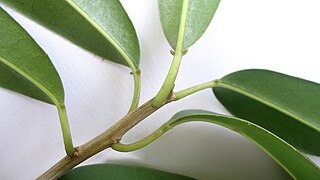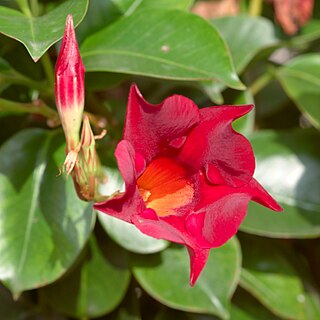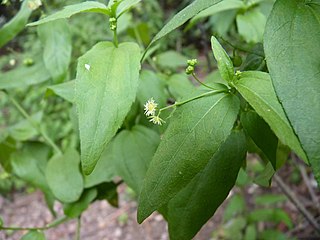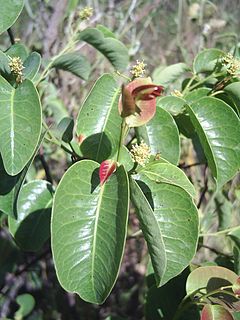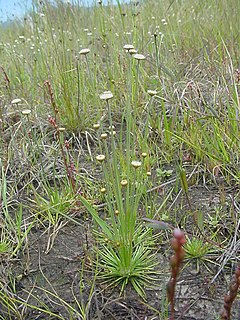| False croton | |
|---|---|
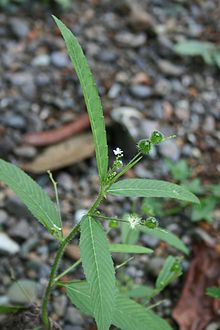 | |
| Caperonia palustris | |
| Scientific classification | |
| Kingdom: | Plantae |
| Clade: | Angiosperms |
| Clade: | Eudicots |
| Clade: | Rosids |
| Order: | Malpighiales |
| Family: | Euphorbiaceae |
| Subtribe: | Ditaxinae |
| Genus: | Caperonia A.St.-Hil. |
| Synonyms [1] | |
Caperonia (false croton) is a genus of plants of the family Euphorbiaceae first described as a genus in 1825. [3] [4] The genus is native to tropical and subtropical America and Africa. [1] [5] [6] [7] [8] [9] [10]
A genus is a taxonomic rank used in the biological classification of living and fossil organisms, as well as viruses, in biology. In the hierarchy of biological classification, genus comes above species and below family. In binomial nomenclature, the genus name forms the first part of the binomial species name for each species within the genus.

Plants are mainly multicellular, predominantly photosynthetic eukaryotes of the kingdom Plantae. Historically, plants were treated as one of two kingdoms including all living things that were not animals, and all algae and fungi were treated as plants. However, all current definitions of Plantae exclude the fungi and some algae, as well as the prokaryotes. By one definition, plants form the clade Viridiplantae, a group that includes the flowering plants, conifers and other gymnosperms, ferns and their allies, hornworts, liverworts, mosses and the green algae, but excludes the red and brown algae.
Family is one of the eight major hierarchical taxonomic ranks in Linnaean taxonomy; it is classified between order and genus. A family may be divided into subfamilies, which are intermediate ranks between the ranks of family and genus. The official family names are Latin in origin; however, popular names are often used: for example, walnut trees and hickory trees belong to the family Juglandaceae, but that family is commonly referred to as being the "walnut family".
- Species [1]
- Caperonia aculeolata - S Brazil
- Caperonia altissima - Paraguay
- Caperonia angustissima - Guyana
- Caperonia bahiensis - E Brazil, Paraguay
- Caperonia buettneriacea - S Brazil
- Caperonia capiibariensis - Paraguay
- Caperonia castaneifolia - widespread from Mexico + West Indies to Paraguay + NE Argentina; naturalized in Florida, Alabama
- Caperonia castrobarrosiana - Maranhão
- Caperonia chiltepecensis - Veracruz, Oaxaca
- Caperonia corchoroides - Guyana, Suriname
- Caperonia cordata - S Brazil, NE Argentina, Paraguay, Uruguay
- Caperonia cubana - Cuba
- Caperonia fistulosa - Africa from Mali to Somalia to Namibia
- Caperonia gardneri - Brazil
- Caperonia glabrata - Paraguay, Formosa
- Caperonia heteropetala - S Brazil
- Caperonia langsdorffii - São Paulo, Mato Grosso
- Caperonia latifolia W + C Africa from Togo to Tanzania
- Caperonia latior - Paraguay
- Caperonia linearifolia - S Brazil, NE Argentina, Uruguay
- Caperonia lutea - Guyana
- Caperonia multicostata - E Brazil
- Caperonia neglecta - Veracruz, Honduras, Panama, Colombia, Venezuela, Bolivia
- Caperonia palustris - widespread from SE + SC United States to Paraguay + N Argentina
- Caperonia paraguayensis - Paraguay
- Caperonia regnellii - Minas Gerais
- Caperonia rutenbergii - Madagascar
- Caperonia serrata - tropical Africa
- Caperonia similis - Amazonas in NW Brazil
- Caperonia stenophylla - Minas Gerais, 3 Guianas
- Caperonia stuhlmannii - Tanzania (incl. Zanzibar), Malawi, Mozambique, Zambia, Zimbabwe, KwaZulu-Natal
- Caperonia subrotunda - Somalia
- Caperonia vellozoana - Rio de Janeiro
- Caperonia zaponzeta - Peru
